This is “Darnall-Preston Complexity Index Structure”, section 2.4 from the book Beginning Project Management (v. 1.0). For details on it (including licensing), click here.
For more information on the source of this book, or why it is available for free, please see the project's home page. You can browse or download additional books there. To download a .zip file containing this book to use offline, simply click here.
2.4 Darnall-Preston Complexity Index Structure
Learning Objectives
- Describe each of the external attributes that contribute to project complexity.
- Describe each of the internal attributes that contribute to project complexity.
- Describe each of the technological attributes that contribute to project complexity.
- Describe each of the environmental attributes that contribute to project complexity.
The Darnall-Preston Complexity Index (DPCI™) is designed to develop a project profile that reflects different aspects of the project that will influence the approach to leading and executing the project. The DPCI is built on four categories of attributes:
- External. Environmental attributes that are in existence at the beginning of the project, such as size, duration, and available resources
- Internal. Clarity of project objectives, the clarity of scope, the organizational complexity, and stakeholder agreement
- Technological. Newness of the technology and familiarity of team members with the technology
- Environmental. Legal, cultural, political, and ecological
The DPCI was developed around four assumptions:
- All projects are unique.
- Projects have common characteristics.
- These characteristics can be grouped together to create a project profile.
- There is an optimum execution approach for each project profile and therefore an optimum set of skills and experience for the project manager and execution team.
External Attributes
The external attributes include those issues that are typically established early in the project definition phase and are usually outside the direct control of the project management team. The project size can be a product of the dollars needed to execute the project or project cost. The cost of the project is estimated during the conceptual phase of the project. At the time the project is authorized, the cost or size of the project is established. The duration or time allocated to complete the project and the resources available are also attributes that are established when the project is authorized.
Size
Project size is a relative concept. How do we decide if something is large or small? A 150-pound person is big if the person is ten years old. A 150-pound person is small if the person is a professional football lineman. The frame of reference provides the context in which size is determined.
The size of a project is also relative. A $250 million oil refinery expansion is a relatively small project in an industry where billion dollar projects are common. A $250 million pharmaceutical development project or software development project would be considered a large project. The size of a project is determined by the context of the industry and the experience of the team executing the project.
Within the construction industry, firms usually specialize in projects that fall within a defined range. Small firms usually execute small projects and large firms usually execute larger projects. There is a size range for which the company experience, management skills, tools, and work processes are primarily designed. This size range or comfort zone exists for both the company and the members of the project team executing the project.
Figure 2.4

Tools and skills must match the size of the project.
© 2010 Jupiterimages Corporation
When a project team executes a project outside their comfort zone, stress is placed on both the tools and project team. When a project is larger than the comfort zone of a company, stresses are placed on the ability to provide experience and appropriate work processes, and the results are typically cost overruns and schedule delays. To mitigate this stress, some companies will divide large projects into smaller projects and execute the smaller projects with separate dedicated staff and resources. The key to success then becomes the coordination of the small projects to behave as if they are one large project.
Copper Mining in Argentina
One example of this process was a copper mining project in Argentina. The comfort zone of the company was projects ranging from $150 million to $500 million. Projects over $500 million were divided into smaller projects. The mining project was estimated to cost a little over $1 billion and the project was divided into three projects, each with a project manager and leadership team. Although the projects shared some resources and reported to an oversight project manager, each project developed a separate execution plan that included a budget and schedule.
Figure 2.5

Large open pit mining project.
© 2010 Jupiterimages Corporation
When a company is executing a project that is much smaller than the company norm, resources are often misused and inappropriate work processes are utilized. The result often increases the project costs. Some companies with a history of executing large projects have set up a small project group to execute smaller projects. These groups establish a different culture, develop appropriate work processes, and use tools designed to execute smaller projects.
The more the project size is outside the comfort zone of the project, the more stress is created for the project. This is true on both ends of the spectrum. Both smaller and larger projects that fall outside the comfort zone of the project management team will create stress for the project. New skills, tools, and processes will need to be developed to manage the project, and this activity will absorb management time and energy. The higher the stress level created by executing a project outside the comfort zone of the organization, the greater the impact on the complexity level of the project.
Duration
The duration of a project is often set by the parent organization that charters the project with a deadline that reflects the business purpose of the project. The following are examples of projects with end dates that are established to meet the organization’s business purpose:
- A new software program for a university to be implemented in time for registering students in the fall
- A new product to be introduced to the marketplace at the industry’s major conference
- A new high school to be constructed and open next fall
The project team also estimates the duration of the project and establishes a project end date based on normal work (e.g., forty hours per week) and the availability of resources.
Sometimes the normal time needed to complete a project is longer than the time available.
Super Bowl Hotel Space
The investors in a planned hotel start booking rooms for an upcoming Super Bowl weekend a year before the hotel is finished. This is six weeks ahead of the time estimated to build and open the hotel. People will be working overtime, suppliers will be paid a bonus to supply materials early, and management is meeting with city officials to expedite permitting issues. A new project schedule is developed based on these changes to the execution approach, and now the project schedule has zero float.
The result of this six-week compression to the project schedule is additional stress on the project. Significant management time and energy will be invested in tracking and managing schedule issues. Every issue that arises will need to be resolved quickly and involve the project’s senior manager to assure the project schedule does not slip. This additional stress increases the overall project complexity.
Resource Availability
Projects require both human and tangible resources. The project requires people with the right experience, knowledge, and skills to accomplish the assigned tasks. Construction projects typically require resources such as bricks and cranes. Some projects require specialized subcontractors with skills not found within the project team. Each of these resources required by the project will be needed at the point in the project schedule when the materials or skills are required. When these resources are scarce or not available, additional management time and energy is needed.
Boeing Dreamliner
In 2003, Boeing announced the development of the new 787 Dreamliner Airplane. The airframe for the new airplane was a new composite material. During the same period that Boeing was beginning construction of the new manufacturing facility, other new planes were announced, and the Air Force increased its demand for people with airplane manufacturing and maintenance experience. A project was chartered to train the people the new plant would need to manufacture the Boeing Dreamliner. The project manager found that the people with the skills and knowledge needed to develop the curriculum and train the workers were in short supply. In addition to the lack of skilled trainers, the materials needed for the workers to train on were also scarce. The project manager dedicated significant time and energy developing the resources the project needed.
When resources needed to execute the project are not readily available, the project leadership dedicates more management time and energy to acquiring the resources or finding innovative solutions to accomplish the project goals without the needed resources or with creative alternative solutions. The more time and energy the management team must dedicate to searching for resources or alternatives, the more stress on the project. The more scarce and more important the resources, the more stress that is placed on the project.
Internal Attributes
The internal attributes are within the control or influence of the project manager. Internal attributes include clarity of objectives, clarity of scope, the organizational complexity, and stakeholder agreement. Although the clarity of objectives, as with the other attributes, can be improved during the life of the project, the project profile reflects the project at a given time. If the project objectives are not clear during the evaluation of the project, this lack of clarity impacts the complexity of the project.
Clarity of the Project Objectives
Project decisions are made based on how these decision help the project meet its objectives. If the objectives are unclear, the team will not make the best decisions. The greater the confusion for the project team on the goals and objectives of the project, the greater the impact on the complexity of the project.
Confusion Over Objectives in Philadelphia
A consultant was asked to evaluate the likelihood of success of a large project in Philadelphia. The consultant interviewed the project leadership and asked if the goals of the projects were clear. Each member of the leadership team responded that the goals and objectives were clear. When asked what the goals were, the answers varied greatly.
Clarity of Objectives Saves Millions
A critical piece of equipment was being fabricated in Europe for a construction project in South America. The cost to transport the equipment by air was $200,000 more than by ship. Transporting the equipment by ship would also delay the project two months. Early in the project, it was determined that any delay in the project would cost the project over $1 million per month. Because the goals of the project were well understood, the decision to transport the equipment by air was made quickly and easily.
Island Ecology Protected
A large mining company initiated a copper mining project on an ecologically sensitive island in Indonesia. The company stated very clearly and forcefully that every effort would be made on the project to protect both the human and natural environment of the island during construction and operation. Every major decision passed through an evaluation of the impact on the island ecology. Although the island ecology increased the complexity of the project, the clear goals mediated the project complexity.
Clarity of Scope
The project scope defines what is inside the project and what is outside. Does the project to train five hundred technicians for the Boeing 787 include recruiting and assessing potential employees? The project scope did include recruitment and assessment, but hiring processes and drug testing belonged to Boeing. This scope was clear about which responsibilities belonged to the contractor doing the training and which responsibilities belonged to the parent organization.
Figure 2.6

Confusion about the scope and objectives must be avoided.
© 2010 Jupiterimages Corporation
Not all project scopes are this clear. The development of a clear project scope depends on information available about what products and services will be required. A project to develop a vaccine for a new strain of flu may not include sufficient information to develop the processes the team will utilize to understand the flu virus and develop a vaccine. As the team develops more information, the scope can be further developed.
Leadership time and energy will be focused on developing scope clarity. The lack of clarity and the amount of time needed by the leadership team to develop a clear scope will add to the project complexity.
Organizational Complexity
The structure of the project’s client organization and the organizational decision-making processes influence the project complexity. A project with one client as the central point for making decisions and providing client approvals and technical information has only one relationship to manage and a streamlined communication process. Projects with a team representing the client require more of the project manager’s time and energy managing the client relationships and communication process. The client team approach brings more expertise and often more comprehensive project oversight, but it adds to the project complexity.
Stakeholder Agreement
Often there is more than one major stakeholder in the project. An increase in the number of stakeholders adds stress to the project and influences the project’s complexity level. The business or emotional investment of the stakeholder in the project and the ability of the stakeholder to influence the project outcomes or execution approach will also influence the stakeholder complexity of the project. In addition to the number of stakeholders and their level of investment, the degree in which the project stakeholders agree or disagree also influences the complexity of the project.
A small commercial construction project will typically have several stakeholders in addition to the client. All the building permitting agencies, environmental agencies, and labor and safety agencies have an interest in the project and can influence the execution plan of the project. The neighbors will have an interest in the architectural appeal, the noise, and the purpose of the building.
Tire Plant in India
A U.S. chemical company chartered a project team to design and build a plant to produce the raw materials for building truck tires designed for nonpaved roads. The plant was to be built in India a few years after an accident that killed several Indians and involved a different U.S. chemical company. When the company announced the new project and began to break ground, the community backlash was so strong that the project was shut down. A highly involved stakeholder can significantly influence your project.
Wind Turbine on a College Campus
A small college in South Carolina won a competitive grant to erect and operate a wind turbine on campus. The engineering department submitted the grant as a demonstration project for engineering students to expose students to wind technology. The campus facilities department found only one location for the wind turbine that would not disrupt the flow of traffic on campus. The engineering department found that location unacceptable for students who had to maintain the wind turbine. The county construction permitting department had no policies for permitting a wind turbine and would not provide a building permit. The college had to go to the county council and get an exception to county rules. The marketing department wanted the wind turbine placed in a highly visible location to promote the innovativeness of the college.
Each of the college’s stakeholders had a legitimate interest in the location of the wind turbine. The number of stakeholders on the project, multiplied by their passion for the subject and the lack of agreement on the location, increased the complexity of the project. Significant time and resources of the project will be dedicated to identifying, understanding, and managing client expectations.
Technological Complexity
The technology of a project refers to the product of the project and not the technology used to manage the project. This technology is typically unique to the industry. A pharmaceutical project technology is the drug-making technology or pharmacology. The technology for a project to build a new automobile plant is the car production process. The key stress on the project is the newness of the technology. What aspects of the technology are known, and what aspects are unknown? Does the project combine technologies on the project that have never been combined?
Project technology that is newer and more complex will require more technological expertise on the project team.
Family Life Center
A church in western New York decided to build a new family life center that would not use electricity from the power grid. The charter of the project included statements that required the building to use renewable power sources and have an environmentally friendly footprint. The project required the adaptation of a new technology for producing and managing power, location of the building relative to the sun, and landscaping to minimize water usage. Most of the technology was tested, and the project team brought in experts to help design and implement a program to meet the requirements of the project. The technology of the project required the project team to develop a new understanding of this technology and work processes to adapt the project to address the requirement of the technology.
Typically, the newer the technology and the less familiar the project team is with the technology, the greater the stress and the contribution to the complexity of the project.
Project Environment
The project environment includes all the issues related to the environment that will influence the development and execution of the project plan. A project to build an airport expansion in Pittsburgh, Pennsylvania will have very different legal, cultural, political, and ecological issues to address from an airport expansion in São Paolo, Brazil. The environment attributes in Brazil require more planning, resources, and leadership attention to successfully execute the project. The greater the number and difficulty of the issues, the greater the influence on the complexity of the project.
Legal
The legal issues on a project can be broad and include many different levels of government. Most local governments have various permits, such as business licenses and building permits, required to do work. Some projects will have security issues and will work with local law enforcement.
Figure 2.7

Legal problems increase the project’s complexity.
© 2010 Jupiterimages Corporation
Workforce laws vary significantly in country, regional, and local jurisdictions. The hiring and management of workers can be a complex and time-consuming issue for some projects. Companies not used to working in a union environment will invest project resources in learning and adapting to the new environment. Scheduling holidays, supporting maternity leave, and dealing with workforce reduction issues surrounding project closeout will vary in each environment, industry, and project. Understanding and managing workforce issues on a project can be simple or very complex.
National, regional, and local taxes require a project tax approach or policy on most international projects and some domestic projects. Duties for equipment and material brought into a country add complexity to the procurement plan. Equipment used temporarily to execute the project, such as a crane, is treated differently than permanently installed equipment, such as a pump. In some countries, a third party is hired to expedite the flow of materials through complex custom processes.
Copper Mining in Argentina
The new president of Argentina instituted a program to encourage economic development. One of the projects to support this program was a copper mining project in northern Argentina. This is the desert area of Argentina with a basic agrarian economy. A joint venture was formed with the encouragement of the Argentina government between a Canadian and Australian Company with all three entities owning a share of the new company.
The conceptual design work was done in Canada with support from offices in Chile, Argentina, and the United States. A U.S. contractor was awarded the contract to design, procure equipment, and build the mine. The project leadership team included members from the United States, Canada, Australia, Argentina, Chile, Puerto Rico, Cuba, and Lebanon. Materials were procured, transported, and brought through customs from twenty-one different countries. Legal issues on this project consumed a great deal of management attention and sometimes affected the project execution. Materials were occasionally delayed in customs, people with critical skills could not get visas to enter Argentina, and which country’s laws would apply to the contracts had to be debated.
Not every project will have significant legal issues. When legal issues are involved, they are typically significant and will add to the complexity of the project. Understanding the legal issues than can affect the project and developing a plan to address these issues will reduce the complexity of the project.
Cultural
Culture is a term that reflects the community’s assumptions, norms, values, and artifacts. Community includes the parent organization charting the project, the local community or communities where the project is executed, and the region and country where the project is located. The project team must understand the community’s culture and its potential impact on the project.
Culture also defines the meaning of work, truth, the value of nature, relationships, and how to communicate. Projects executed in various cultures will often experience cultural conflict.
Gender Difficulties in Argentina
A project team from the United States was responsible for executing a project in Argentina. The U.S. leadership team included women in key leadership positions, and the Argentines refused to take direction from females. The U.S. team believed strongly in their leadership capability and refused to make changes. This conflict was settled by senior managers of both organizations, and rules were established that respected all team members in leadership roles. The conflict did not go away, but the team was able to successfully execute the project with the original team. Delays were experienced on the project that could be traced to this cultural conflict.
Many organizations have rule-based cultures. Institutions of higher learning, organizations related to judicial organizations, and most government organizations are examples of rule-based organizations. The organizational structure and culture inhibits risk taking through established rules and policies. Projects are goal based and focus on plans and processes to achieve goals. Goal-based cultures promote assuming risk to achieve goals. Projects that are closely tied to a rule-based parent organization will often find conflict with the parent organization’s need to follow rules and the project’s need to accomplish goals. This conflict creates additional stress that adds to the project complexity.
Figure 2.8

Dealing with diverse cultures increases complexity.
© 2010 Jupiterimages Corporation
On global projects, language, cultural conflict with the role of women, the religious role in daily activities, and even the concept of time can becomes issues on the project. These issues require project leadership to resolve and they add to the project complexity. In some countries and even different companies in the same country, meetings start on time, and a person arriving five minutes late will cause major disruption. In other situations, meetings can start within thirty minutes of the starting time without anyone objecting.
Communication Problem in India
A team of project experts was sent to India to evaluate a large construction project. The team arrived and reviewed the project documents and found the project on time and meeting all project goals. After spending three days with various contractors and team managers, the team discovered the project was significantly behind schedule and would miss an important window during the monsoon season. A culture existed on the project where workers told the project management what they expected to hear, and the difference between the progress of the project team and the progress reports became so large that the difference could not be reconciled during the original schedule of the project.
An increase in the number of cultures represented on the project team raises the cultural complexity. Increases in the number of cultures with which the project team must interface also increase the complexity of a project. Although this cultural diversity creates leadership challenges, it also presents opportunities. The diversity of cultures presents various approaches to solving problems, and the project manager may find innovative solutions easier to develop with a diverse project team.
Political
Every project operates within one or more communities that reflect organizational dynamics and power struggles. The more important the project is to the organizational leadership, the more invested various organizational leaders will be in the project. The more people that become invested in the project and the more influence these people exhibit on the resources and activities of the project, the more time and energy will be expended by the project team in managing these outside influences. This additional stress on project leadership time and resources adds complexity to the project.
Stakeholders and a Bridge Project
The Department of Highways chartered a project to upgrade a number of bridges that crossed the interstate in one of the larger cities in South Carolina. The closing of these bridges severely impacted traffic congestion, including a large shopping mall. The contract included provisions for minimizing the impact on the traffic and communities near the construction areas. This provision allowed businesses or interested parties to review the project schedule and make suggestions that would lessen the impact of the construction. The project leadership invested significant time and resources in developing alignment among the various political stakeholders on the project approach and schedule.
Ecological
Projects have the potential to impact the living conditions or the health of people, plants, and animals. In addition to the potential impact to land, water, and air, the ecology includes the sights and sounds that can impact the quality of life. An increasing number of clients expect the project team to minimize the impact of the project on the ecology. An ecology that is more sensitive to disruption and a more disruptive technology will place greater stress on the project and increase the project complexity. Construction projects that require the use of explosions to effectively move rocks and dirt, projects that require the addition of twenty-five people in existing office space, and projects that require the release of strong odors like those from adhesives in an office environment will all impact the ecology. The project team develops means and methods to minimize the impact of the disruption in a manner consistent with the requirements as communicated by the client. The effort that is needed to minimize the ecological impact will influence the complexity of the project.
The ecology will also impact the execution of a project. The weather is an attribute of most construction projects. Construction projects in India are often scheduled around the monsoon season, and construction projects in the Caribbean consider the hurricane season. A project to build an offshore wind farm will require an understanding of the ocean currents, the wind currents, and temperature fluctuation to understand the impact of the ecology on the project execution plan.
The larger the number of potential ecological attributes and the greater the impact of each attribute, the greater the influence on the project complexity.
Key Takeaways
- The external attributes are the relative size of the project, duration of the project, and the available resources.
- The internal attributes are the clarity of its scope, the complexity of the organization, and the agreement among stakeholders.
- The technological attributes are the technology of the product (not the technology used to manage the project), the newness of the technology, and the familiarity of the team with the technology.
- The environmental attributes are the legal issues, cultural conflicts, political interests, the impact of the project on the ecology, and the impact of the ecology on the project.
Exercises
- The external attributes considered in the DPCI are relative size, ________, and available resources.
- The internal attributes considered in the DPCI are clarity of scope, complexity of the organization, and agreement among _________.
- The technological attributes considered in the DPCI are ______ of the technology and familiarity of the team with the technology.
- The environmental attributes considered in the DPCI are _____, cultural, political, impact on the ecology, and impact of the ecology on the project.
- Under what circumstances would a large project qualify for a low DPCI score?
- Describe an organization structure that would receive a high score for complexity.
- Does the technology attribute refer to the technology used by the project team or the project itself?
- Give an example of a cultural problem that would have a high-complexity score.
- Give an example of an ecological problem that would have a high-complexity score.
- What is the difference between an external and an internal attribute in the DPCI?
Behind the Scenes
Stanley PortnyStanley E. Portny, Project Management for Dummies, 2nd ed. (Hoboken, NJ: Wiley, 2007). advocates that as a project manager, you research the source of a project to determine who had the original idea by asking questions of your boss, reading meeting minutes and feasibility studies, and checking other correspondence and contacts. The purpose of this investigation is to find out who is most likely to champion the project if you have trouble, who opposed the project, or whose interests will be harmed by the project. Consider this advice in light of the Darnall-Preston Complexity Index and answer the following questions:
- Is this an external, internal, technological or environmental attribute? Explain your reasoning and refer to the definitions provided. A case can be made for putting it in more than one.
- What might you find that would increase the project’s complexity and what might you find out that would reduce the complexity? Provide examples of each.




